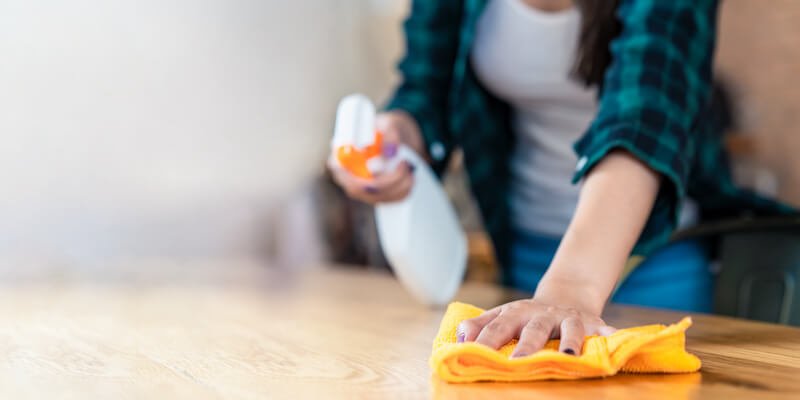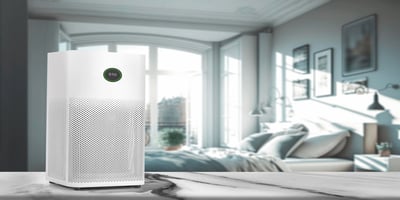What Is TVOC and Why It Matters for Indoor Air Quality
Key Takeaways
- TVOC captures all volatile organic compounds in a single measurement, expressed in micrograms per cubic meter (µg/m³) or parts per billion (ppb).
- Your paint, furniture, cleaning supplies, even your carpet? All releasing VOCs right now.
- Short-term exposure triggers headaches and eye irritation, while years of exposure can damage your liver, kidneys, and respiratory system.
- Public Health England says keep TVOC levels below 300 µg/m³ for comfort.
- Fighting back requires three tactics together. Source control, ventilation, and air purification.
Ever walked into a freshly painted room and felt that sharp chemical smell hit you? That's volatile organic compounds, though most VOCs don't smell like anything at all and float invisibly through your home, affecting your TVOC air quality without you ever knowing. So what is TVOC, exactly? It stands for Total Volatile Organic Compounds, measuring the combined concentration of all these chemicals evaporating into your air at once.
VOC vs. TVOC and Why the Difference Matters
A volatile organic compound is basically any carbon-based chemical that evaporates at room temperature. Your pressed wood furniture releases formaldehyde. Stored gasoline gives off benzene. Paint thinner emits toluene. All VOCs.
That's where TVOC meaning becomes useful. Nobody wants to test for hundreds of individual chemicals. Too expensive. Too complicated. Instead, air quality pros measure everything at once and give you a single number. When your air quality monitor displays a TVOC reading, you're seeing the total concentration of every detectable organic compound in that space combined.
Scientists break these compounds into categories based on how quickly they evaporate, which helps clarify the full TVOC meaning in practice. VVOCs like propane and butane disappear almost instantly. Standard VOCs including formaldehyde and acetone evaporate at moderate rates. SVOCs such as pesticides and flame retardants take their time, but they still add to your indoor pollution load over weeks and months.
Where Do These Compounds Come From?
 You might think VOC exposure only happens during big projects. Painting the bedroom. Refinishing the floors. Wrong.
You might think VOC exposure only happens during big projects. Painting the bedroom. Refinishing the floors. Wrong.
Your home releases these compounds constantly from stuff you never think about. Building materials and furnishings top the list. That particleboard bookshelf from IKEA? It contains formaldehyde-based glue that off-gasses for years. New carpets pump out dozens of different VOCs from the synthetic fibers, the backing, and the adhesive underneath. And that "new furniture smell" everyone loves? Pure VOCs escaping into your living space.
Household products pile on even more. The worst offenders include:
- Cleaning sprays, disinfectants, and bleach
- Air fresheners, scented candles, and plug-in fragrances
- Paints, varnishes, and wood stains
- Hairspray, cologne, and nail polish remover
- Dry-cleaned clothes still carrying perchloroethylene
Daily activities generate VOCs too. Frying bacon releases compounds from the heated oil. Cigarettes introduce hundreds of chemicals with every puff. Even breathing adds trace amounts of acetone to the air.
Most people don't realize this. The EPA's Total Exposure Assessment Methodology studies found indoor VOC levels running 2-5 times higher than outdoor air. Why? Modern homes seal tight for energy efficiency. Great for your heating bill. Terrible for trapping pollutants inside with you.
Health Effects and Why TVOC Levels Matter
Knowing what is TVOC in air quality monitoring actually protects you. These aren't theoretical risks. Millions of people suffer symptoms right now without connecting the dots to their indoor air.
Short-term effects show up within hours. Leave the building, and they usually fade. Doctors sometimes call this Sick Building Syndrome. Common symptoms include:
- Pounding headaches that won't quit
- Eyes burning like you've been chopping onions
- Dizzy spells and waves of nausea
- Exhaustion even after a full night's sleep
- Dry, itchy skin or unexplained rashes
Long-term effects develop slowly from months or years of exposure. The EPA has linked chronic VOC exposure to liver and kidney damage, worsening asthma and other respiratory conditions, and cancers tied specifically to benzene and formaldehyde. Research also points to reproductive issues and developmental delays in children.
Kids face higher risks. So do elderly adults and anyone with existing breathing problems. Their bodies absorb more of these compounds or struggle harder to eliminate them.
What TVOC Levels Should You Aim For?
Not every TVOC levels reading signals danger. Some background concentration exists in virtually every indoor space. Your body handles low-level exposure just fine. The TVOC meaning in practical terms comes down to one question. When should you actually worry?
Public Health England draws the line at 300 µg/m³ over an eight-hour period. Stay below that, and you're in good shape. Creep above it, and you'll want to take action.
|
TVOC Level (µg/m³) |
Rating |
What You Should Do |
|
0–300 |
Good |
Relax. Normal ventilation handles this fine |
|
300–1,000 |
Fair |
Open some windows. Get air moving |
|
1,000–3,000 |
Poor |
Hunt down the source and ventilate hard |
|
3,000+ |
Very Poor |
Act immediately. Something's seriously off |
The World Health Organization uses parts per billion instead. Under 400 ppb? Acceptable. Over 2,200 ppb? That's dangerous territory requiring immediate intervention.
Context matters too. Spiking to 800 µg/m³ while sautéing garlic? No big deal. Sitting at 1,200 µg/m³ all day every day? That needs fixing.
Monitoring Your Indoor Air Quality
Can't manage what you can't measure. Without tracking TVOC air quality, you're basically guessing and hoping for the best.
Fortunately, modern monitors have made this accessible for regular homeowners. These devices use metal oxide sensors or photoionization detectors to measure organic compound concentrations continuously. Quality units provide real-time readings, store historical data, and alert you when levels spike.
The Sensibo Elements smart air quality monitor tracks TVOC plus five other metrics. PM2.5 particulate matter. CO₂ equivalent. Ethanol vapors. Temperature. Humidity. Six sensors in one compact device giving you the complete picture. The LED on the front changes color based on your air quality. Green means breathe easy. Orange or red? Time to investigate. Through the Sensibo app, you can pull up detailed graphs showing how TVOC levels rise and fall throughout the day, get push notifications when something spikes, and receive specific tips for clearing the air.
Placement affects accuracy. Position your monitor at breathing height, somewhere between 3-5 feet off the ground. Pick a room where you spend real time. And avoid placing it right next to obvious VOC sources, near drafty windows, or in dead corners where air stagnates.
Practical Strategies for Reducing TVOC Exposure
Lowering your TVOC levels takes a three-pronged attack. Eliminate sources. Dilute what remains through ventilation. Remove the rest with purification.
Source control delivers the biggest bang for your buck. No amount of ventilation fixes a major emission source sitting in your living room. Grab low-VOC or zero-VOC paints next time you're at Home Depot. Let new furniture and mattresses air out in the garage for a week before bringing them inside. Move solvents, gas cans, and automotive chemicals to a detached shed. Swap your Febreze for fragrance-free alternatives, and skip the Glade plugins entirely since they're just adding more chemicals to your air.
Ventilation works by swapping polluted indoor air for fresher outdoor air. Crack windows when weather cooperates. Run bathroom and kitchen exhaust fans while cooking and cleaning. Make sure your HVAC system's fresh air intake actually functions. The goal goes beyond moving air around. You want to push contaminated air out and pull clean air in.
Air purification catches what the first two strategies miss. One caveat though. Standard HEPA filters grab particles but let gases sail right through. Removing VOCs requires activated carbon filtration, which traps organic compounds across millions of microscopic pores.
The Sensibo Pure smart air purifier stacks HEPA filtration with activated carbon to handle both particulate matter and gaseous pollutants. When its built-in sensor detects rising pollution, the fan speed automatically kicks up. Pair it with Sensibo Elements through PureBoost technology, and it activates on its own whenever TVOC spikes. No buttons to push. Works with Alexa, Google Assistant, and Siri too if you prefer voice commands.
For messy projects, timing helps too. Paint on a Saturday morning when you can leave windows open all day. Refinish floors in summer, not January. If cold weather forces you indoors, run exhaust ventilation nonstop and sleep in another room until concentrations drop.
Special Considerations for High-Risk Situations
 Some scenarios demand extra vigilance with TVOC air quality. New construction tops the list. Fresh drywall, paint, adhesives, and finishes release massive amounts of VOCs. The first six months after completion typically see the worst concentrations, though some materials keep off-gassing for years.
Some scenarios demand extra vigilance with TVOC air quality. New construction tops the list. Fresh drywall, paint, adhesives, and finishes release massive amounts of VOCs. The first six months after completion typically see the worst concentrations, though some materials keep off-gassing for years.
Moving into a new build? Ask the builder to run the HVAC continuously for a few weeks before you take possession. Delay move-in if you can swing it. At minimum, run every fan you own and keep windows cracked during those first few weeks.
Nurseries deserve special attention. Babies breathe faster than adults and spend more time down near the floor where heavier VOCs settle. Choose solid wood over particle board. Use zero-VOC paint. Let new cribs and changing tables off-gas in the garage first.
Don't overlook your home office. Eight-plus hours a day in a small room adds up fast. Make sure you've got adequate airflow, ditch the synthetic air fresheners, and consider a monitor to catch issues before symptoms start.
Taking Control of Your Indoor Air
VOCs stay invisible. That's exactly why active monitoring beats waiting for symptoms or trusting your nose. Start with source control, add better ventilation, or invest in dedicated air quality monitoring. Any action puts you ahead of the millions breathing contaminated air without even knowing it.
FAQ
What is a safe TVOC level for homes?
Public Health England recommends staying below 300 µg/m³. Between 300-1,000 µg/m³, you'll want more ventilation. Above 1,000 µg/m³? Start hunting for the source.
How quickly do TVOC levels drop after removing a source?
Depends entirely on what you removed and how well you ventilate. Light compounds clear within hours if you open windows. Heavy off-gassing from furniture and building materials? That takes weeks or months even with good airflow.
Can plants reduce TVOC levels?
NASA ran famous studies showing certain plants absorb specific VOCs. Sounds great. The catch? You'd need a jungle's worth of plants to make any real dent. A decent air purifier outperforms a roomful of spider plants every time.
Do TVOC levels vary by season?
Absolutely. Summer heat accelerates off-gassing, so concentrations often climb. Winter brings its own challenges. Sealed-up homes trap pollutants that would normally escape. Monitor year-round instead of assuming you're safe in any particular season.
Should I be concerned about TVOC from essential oil diffusers?
This one surprises people. Essential oils are VOCs by definition. They're volatile organic compounds extracted from plants. Generally less harmful than synthetic chemicals, but they still add to your total concentration. If you've got asthma or respiratory sensitivities, go easy on the diffuser.






































.jpg?height=200&name=photo_2024-07-25_21-02-41%20(1).jpg)